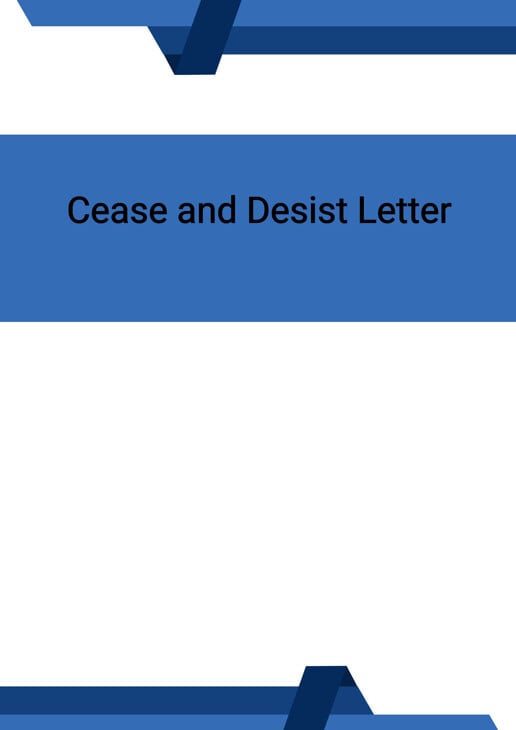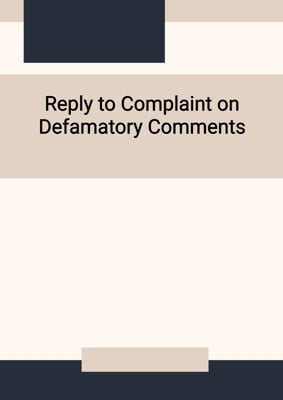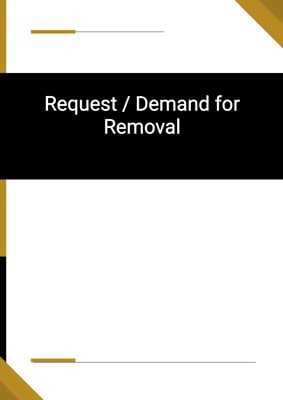How to Tailor the Document for Your Need?
01
Create Document
Click "Create Document" button and the document will be prepared with your account details automatically filled in.
02
Fill Information
Please fill in any additional information by following the step-by-step guide on the left hand side of the preview document and click the "Next" button.
03
Get Document
When you are done, click the "Get Document" button and you can download the document in Word or PDF format.
04
Review Document
Please review the document carefully and make any final modifications to ensure that the details are correct before sending to the addressee.
Document Preview
Document Description
A cease and desist letter is a written notice demanding the recipient to immediately stop an illegal or allegedly illegal activity. Although it is generally not legally binding, it is a formal step that may be followed by a lawsuit if the recipient ignores it.
Litigation can be time-consuming and costly for all parties involved, and thus some may want to resolve the matter with a cease and desist letter to avoid going to court. This letter will equally serve as evidence that one has given notice to the other party, which strengthens a legal claim if the other party continues the alleged illegal activity.
It is illegal to make untruthful comments about another person that harm their reputation and business, whether in print or speech. Thus, in the context of defamation, a cease and desist letter can be used to stop false statements such as the following:
• inaccurate information in news articles;
• fake online reviews;
• untruthful social media posts & comments;
Cease and desist letters are not automatically filed with courts such that they are sent directly to the recipient or the company, intending to resolve the issue outside of court. Generally, cease and desist letters are quite effective since businesses and individuals often choose to adhere to them to protect themselves against further legal action.
The letter starts by stating the purpose, which is to address the issue of defamation. It highlights that the recipient has made malicious and unsubstantiated statements about the sender, causing harm to their reputation. The specific defamatory statements are mentioned, and it is emphasized that they were either spoken or written, depending on the circumstances.
The letter explains that under the applicable jurisdiction's laws, the statements have been communicated to third parties, resulting in a negative opinion or impression of the sender. It states that this constitutes either slander or libel, depending on the form of communication. The damages caused by these statements are described as irreparable.
The sender then proceeds to make three demands to the recipient. Firstly, they demand an immediate retraction of the statements. Secondly, they require the recipient to cease making any further defamatory statements. Lastly, they request a signed written assurance from the recipient, confirming their commitment to refrain from any future acts of defamation.
If the recipient has also caused harm through their actions, an additional demand for a public apology is included in the letter. The sender warns the recipient that failure to comply with these demands will result in legal action. They mention the potential consequences, such as seeking preliminary and permanent injunctions, monetary damages to their reputation, and reimbursement of legal fees.
The sender emphasizes that this letter serves as the final warning and that if the recipient does not retract the statements and issue the apology by the specified deadline, a lawsuit will be initiated immediately. They also state their intention to monitor any further statements made by the recipient and take appropriate legal action if necessary. The recipient is given a deadline to acknowledge the letter and confirm their compliance with the cease and desist demands. The sender concludes the letter by offering their contact information for any inquiries.
How to use this document?
1. Gather personal information: Collect the account holder's first name, last name, address, and email.
2. Address the recipient: Obtain the respondent's address to properly direct the letter.
3. State the purpose: Clearly explain that the letter is addressing the issue of defamation and the harm caused by the recipient's statements.
4. Specify defamatory statements: Identify the specific statements made by the recipient that are considered defamatory.
5. Determine slander or libel: Assess whether the statements were spoken or written to determine if they constitute slander or libel.
6. Describe damages: Explain the irreparable damages caused by the defamatory statements.
7. Make three demands: Demand the retraction of the statements, cessation of further defamatory statements, and a signed written assurance of no future acts of defamation.
8. Request public apology (optional): If applicable, require the recipient to issue a public apology.
9. Warn of legal action: Clearly state the consequences of non-compliance, such as seeking injunctions, monetary damages, and reimbursement of legal fees.
10. Set deadline: Specify a deadline for the recipient to retract the statements and issue the apology.
11. Monitor further statements: Express the intention to monitor the recipient's future statements and take legal action if necessary.
12. Request acknowledgment: Ask the recipient to confirm their compliance with the cease and desist demands within a specified timeframe.
13. Provide contact information: Offer the sender's contact details for any inquiries or questions about the letter.
Not the right document?
Don’t worry, we have thousands of documents for you to choose from:




